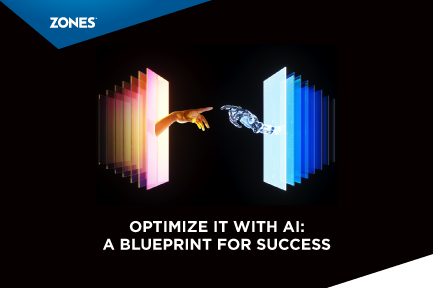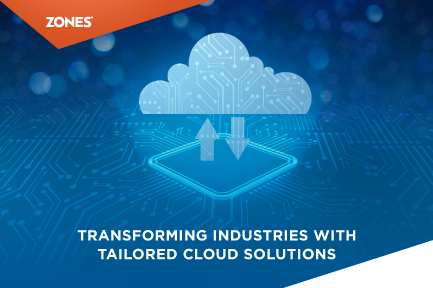The Rise of Industry Clouds: Shaping Vertical-Specific Solutions for the Future
The Shift to Verticalized Cloud Solutions Problem: Adapting generalist cloud solutions to their particular workflows and regulatory needs is a...
3 min read
![]() Zones
:
Jul 31, 2024 2:27:04 PM
Zones
:
Jul 31, 2024 2:27:04 PM

In June 2024, the Everest Group and Zones hosted a tech forum that focused on the pivotal role of artificial intelligence (AI) in transforming IT infrastructure. The event highlighted the challenges and opportunities presented by AI and generative AI (GenAI) adoption, providing critical insights into how enterprises can navigate the evolving technological landscape to become AI-first organizations.
AI and GenAI are poised for significant adoption across business and IT sectors. According to a study by the Everest Group, 91% of respondents believe that GenAI will be adopted in IT. However, the journey from pilot phases to full-scale implementation remains a significant hurdle. Less than 5% of enterprises that have completed the pilot phase of GenAI have progressed to the production phase. Despite these challenges, the potential benefits are substantial, with a projected 35% increase in productivity across cloud and infrastructure services achievable through GenAI.
The transformation driven by AI in IT infrastructure can be understood through two primary lenses: AI adoption for IT infrastructure and IT infrastructure for AI adoption.
Real-Time Response Recommendation: Improving the speed and accuracy of customer support.
Predictive Asset Maintenance: Reducing downtime and maintenance costs through predictive analytics.
Automated Network Monitoring: Enhancing network reliability and efficiency.
Threat Detection and Response: Strengthening cybersecurity measures.
Cost Optimization: Improved cost management through automated ticket resolution and improved mean time to repair (MTTR).
Modernizing IT infrastructure is crucial for leveraging AI technologies effectively. Key considerations include:
Legacy Hardware Limitations: Outdated hardware can impede AI model training and deployment.
Cybersecurity Vulnerabilities: While AI can make legacy infrastructure more susceptible to cyber attacks, it can also enhance security measures.
Scalability and Flexibility: Modern infrastructure must be scalable and adaptable to meet changing business requirements.
Transitioning to an AI-first organization involves a strategic approach prioritizing problem-solving over mere technology adoption. Key guidelines include:
The forum highlighted several prioritized AI use cases that are transforming IT infrastructure:
Facilitating faster development cycles and improving data quality.
Streamlining the process of moving data across systems.
Automating the setup of IT infrastructure to enhance efficiency.
Utilizing AI for advanced network management and optimization.
Enhancing security measures through AI-driven threat intelligence.]
Improving workplace productivity and satisfaction through AI-driven tools and processes.
The adoption of AI-driven services in IT infrastructure offers several benefits:
Enhancing resource allocation and cost management in cloud environments.
Improving performance and reliability through dynamic resource management.
Streamlining operations and increasing efficiency across the organization.
Strengthening the organization's ability to withstand and recover from disruptions.
Improving network performance and resource utilization.
Strengthening defenses against cyber threats through advanced AI-driven security solutions.
Identifying and addressing potential risks more effectively.
Ensuring adherence to regulatory standards and best practices.
The Everest Group – Zones Tech Forum underscored the transformative potential of AI in reshaping IT infrastructure. As enterprises strive to become AI-first organizations, they must navigate legacy hardware, cybersecurity, data infrastructure, and scalability challenges. By adopting a problem-solving approach and focusing on sustainable and responsible AI scaling, businesses can harness the full potential of AI to drive innovation, efficiency, and resilience in their IT infrastructure.
The insights shared at the forum provide a roadmap for enterprises aiming to stay competitive and thrive in an AI-driven world. Embracing AI enhances IT infrastructure and paves the way for a future where technology and business processes are seamlessly integrated, enabling organizations to achieve new heights of productivity and innovation.
Related Reading
The Key Elements of a Successful Hybrid Cloud Strategy
Overcoming Challenges in Implementing FinOps for Cloud Cost Optimization
Decoding the Employee Experience (EX) Blackbox
Real-Time Monitoring of NOC for Optimum Performance and Efficiency
Avoiding the Most Common Mistakes When Implementing Network Automation
FAQs
Q: What are enterprises' main challenges in adopting AI and GenAI?
A: The main challenges include transitioning from pilot phases to full-scale implementation, modernizing legacy IT infrastructure, addressing cybersecurity vulnerabilities, and ensuring data compatibility and integration.
Q: How can AI enhance IT infrastructure?
A: AI can optimize IT infrastructure through real-time response recommendations, predictive asset maintenance, automated network monitoring, threat detection and response, and cost optimization.
Q: Why is IT infrastructure modernization necessary for AI adoption?
A: Modern IT infrastructure is essential for efficient AI model training, deployment, and data handling. It provides the scalability and flexibility needed to adapt to changing business requirements and enhances cybersecurity measures.
Q: What are some prioritized AI use cases in IT infrastructure?
A: Prioritized use cases include code and synthetic data generation, database migration, infrastructure provisioning, cognitive network operations, threat detection and response, and employee experience enhancement.
Q: What benefits can enterprises achieve through AI-driven services?
A: Enterprises can achieve cloud cost and efficiency optimization, intelligent resource scaling and load balancing, productivity and workflow optimization, business continuity and resilience, enhanced network reliability and resource allocation, elevated cybersecurity measures, risk and vulnerability mitigation, and improved policy and compliance.
For more detailed insights, you can refer to the complete report from the Everest Group – Zones Tech Forum here.

The Shift to Verticalized Cloud Solutions Problem: Adapting generalist cloud solutions to their particular workflows and regulatory needs is a...

Adobe Firefly Generative AI marks a significant leap in digital design, blending advanced artificial intelligence with creative processes. This tool...
-1.jpg)
In today's tech-driven world, AI is a powerful tool that helps organizations unlock new possibilities in how they use data, find creative solutions...